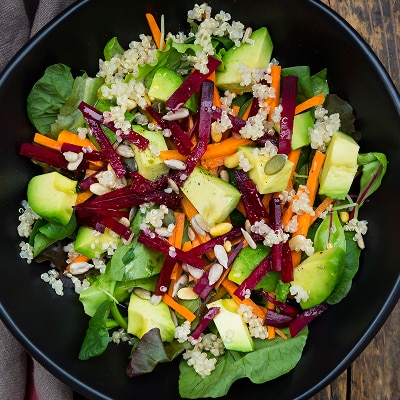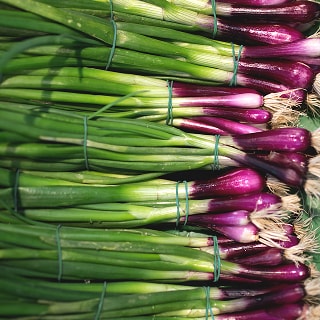
Discover a collection of stories from our authorities on the Longevity Lifestyle, created by ROAR Forward, a collaborative of longevity thought leaders and content creators.
Salads are one of the easiest ways to pack nutrients into a meal, but too often we rely on the same basics—lettuce, tomato, cucumber, carrots—and miss out on ingredients that can help support long-term health and longevity.
“Many of us grew up eating simple salads and still default to those familiar ingredients,” says Brittany Brown, RD IBCLC CDE, of Nova Scotia, Canada. “But the right mix can boost flavor, variety and your health in meaningful ways.”
Dani Dominguez, MS, RDN, suggests starting small: “Explore a local salad bar or market buffet. Sampling new items in small portions is an affordable way to discover what resonates with your taste buds.”
Sometimes, adding just one new ingredient can completely change your salad experience—or give you a fresh appreciation for something you’ve overlooked. “It’s often about finding the right combination to bring a salad to life,” says Brown.
Here, experts highlight 11 nutrient-rich ingredients that can help support gut health, strengthen bones and more. Every forkful is a step toward living a longer, healthier life.

1. Beets
A great source of fiber, this low-calorie root vegetable promotes a healthy gut bacterium to help prevent digestive issues like bloating. “Beets contain water-soluble pigments called betalains, which have antioxidant properties to help reduce oxidative stress,” adds Dominguez. “They’re also rich in betaine, an amino acid derivative that aids in hydration to help keep skin looking good.”
How to prepare:
Beets can be pickled, roasted, boiled, steamed or served raw. Add ¼ to ½ cup of sliced, cubed or wedged beets to a leafy green or arugula salad.
2. Cilantro
This citrusy green herb is filled with antioxidants including vitamins A, C, and K, along with bone-strengthening minerals like calcium and potassium. “Cilantro also contains lutein, a plant pigment that protects against age-related macular degeneration, a leading cause of vision loss,” says Dominguez.
How to prepare
Add 1-2 tablespoons of chopped or whole cilantro leaf to southwestern, Asian-inspired, tropical or citrus-themed salads.
3. Chickpeas
Otherwise known as garbanzo beans, chickpeas are cholesterol-free and low in sodium, two factors that help promote a healthy heart. “They’re also rich in fiber and packed with plant-based proteins and antioxidants to maintain gut health,” says Brown.
How to prepare:
Toss canned or cooked chickpeas with olive oil and spices such as paprika, cumin and garlic powder and roast at 400°F for 25–30 minutes. Add to a grain bowl, Mediterranean or leafy green salad.
4. Sauerkraut
Sauerkraut, a form of shredded fermented cabbage, is rich in probiotics to promote nutrient absorption. “It’s also full of minerals, including iron, potassium, calcium and magnesium,” says Dominguez.
How to prepare:
Add 2 tablespoons of sauerkraut to a leafy green, kale or grain-based salad.
5. Pecans
In raw form, these buttery-flavored nuts are cholesterol and sodium-free and contain vitamins A, E, B6, folate and niacin. “Pecans are rich in immune-boosting minerals such as iron, magnesium, zinc and polyphenols” says Dominguez.
How to prepare
Pecans can be toasted, chopped or halved. Add 1-2 tablespoons to a spinach or arugula salad or a salad containing berries, kale, quinoa, beets or goat cheese.
6. Pumpkin Seeds
Also known as pepitas, pumpkin seeds are a good source of protein, fiber and heart-healthy omega-3 fatty acids. “They’re rich in magnesium, which can lower your risk of diabetes by regulating blood sugar levels, along with antioxidants to support immune health,” says Brown. “They also contain tryptophan, an important amino acid that helps regulate serotonin, a neurotransmitter that plays a role in regulating our sleep and moods.”
How to prepare
Add 1-2 tablespoons of lightly roasted or raw pumpkin seeds to harvest, grain, or leafy green salads.
7. Mango
Mangos are rich in beta-carotene and vitamin C, antioxidants that help with skin repair and immune function. “Known for their juicy flesh, this tropical fruit contains lutein and zeaxanthin, nutrients that play a role in maintaining eye health, along with fiber and potassium, which are important to digestive and heart health,” says Dominguez.
How to prepare:
Add 1-2 tablespoons of cubed or sliced fresh mango to a tropical or summer salad.

8. Green Onion
Otherwise known as scallions, green onions are a good source of fiber and vitamin K, essential for gut and bone health.
How to prepare:
Add 1-2 tablespoons of raw, lightly sauteed or grilled chopped green onions to Asian, Greek, Mediterranean or southwest-inspired salads.
9. Quinoa
Quinoa is a high protein, high-fiber seed containing all nine essential amino acids.
How to prepare:
Add ½ to ¾ cup of cooked (and cooled) quinoa to a grain bowl, Mediterranean, or roasted veggie-based salad.
10. Avocado
This pear-shaped fruit is packed with healthy fats that nourish the brain, helping reduce the risk of cognitive decline. “Avocados also contain antioxidants like lutein, glutathione, and vitamins E and C. And they’re rich in fiber to keep cholesterol levels in check,” says Brown.
How to prepare:
Slice, cube or mash half an avocado before adding it to a southwest-style, tropical, or grain bowl salad.
11. Burrata
A mozzarella-based cheese with a soft and creamy center, “Burrata is rich in calcium and phosphorus to promote bone health, while also being a good source of protein, important for muscle growth and repair,” says Brown. “It also contains vitamin A which contributes to vision health and B12 to help with cognitive function and memory.” Although it can be considered a healthy food choice, it’s important to consume burrata in moderation due to its high fat, calorie and cholesterol content.
How to prepare:
Burrata comes in ball form. Add ¼ to ½ ball to a caprese-style or arugula salad.
Explore more longevity lifestyle stories here.
